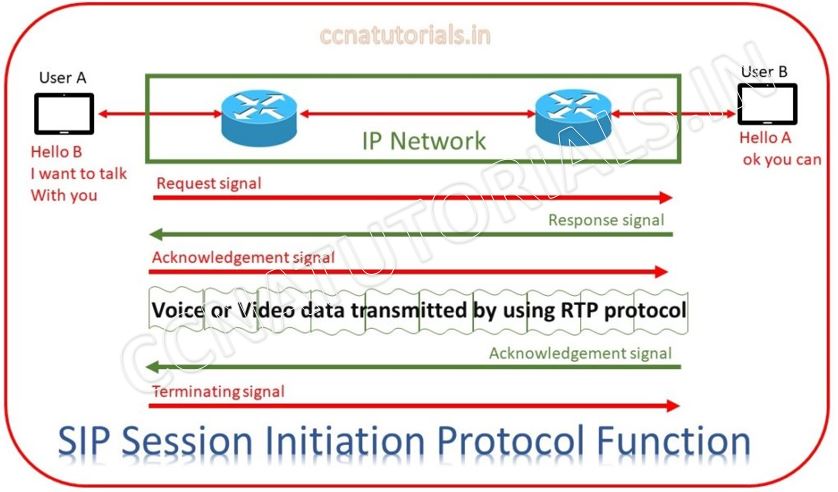In this article I describe the SIP Session Initiation Protocol in computer network for CCNA exam. SIP Session Initiation Protocol is related to application layer of TCP/IP Suite model. The SIP Session Initiation Protocol works for initiate and terminate the session between different devices on the computer network . SIP Session Initiation Protocol allow to forward the packets between different networking devices over the TCP/IP network. SIP Session Initiation Protocol provides the connectivity between different networks for data packets flow from one network to another network. A standard routing table is maintained by the routers for data packet flow between different networks.
Before going to learn about SIP Session Initiation Protocol we need to remember the OSI suite and TCP/IP suite model. There are many manufacturer of computer machine in the market. Initially when computers became single user public computer. The computers communicate with only same brand machines. It happens because there was no any fix standard for data transfer between different devices. It is very difficult to make communication with each other when the hardware are of different brands or company. In this article I describe the some basic part of OSI reference layer and TCP/IP Suite model basic concepts in networking with the SIP Session Initiation Protocol.
OSI reference model basic concepts
OSI reference model in computer network followed by various vendors to overcome the compatibility problem. After implementation of OSI reference model in computer network, equality maintains by all manufacturer. In 1970 the Open Systems Interconnection (OSI) reference model was created by the International Organization for Standardization (ISO). The OSI model was meant to create inter-operable network with different manufactured devices. In this article I describe some layered approach of TCP/IP Suite model basic concepts in computer network. Before understanding the TCP/IP Suite model basic concepts it is necessary to know about the 7 layers of OSI reference model because the basic work of each layer is described in the OSI reference model. You can read the full article related to OSI reference model in computer networking here.
Importance of OSI reference model for SIP Session Initiation Protocol
Before going to know about the SIP Session Initiation Protocol. It is necessary to know the function of application layer in OSI model and TCP/IP model. Initially not only hardware but software also not supported for work the different computer brand. It became very difficult for all computer users to working without implementation of OSI reference model in computer network. It is necessary then to make some common protocols for all vendors of computer. Before implementation of OSI reference model in computer network, all vendors implements their own protocols on computer hardware and software.
In networking OSI reference model became helpful. OSI reference model describes the flow of data between nodes in any network. Data from one computer application to another computer application transfer by following some common protocols. The OSI reference layer also become beneficial for troubleshooting the network problems. TCP/IP and Cisco three layered hierarchical model of Cisco became more helpful alongside the OSI reference model.
The Layered Approach in computer network for SIP Session Initiation Protocol
The Layered approach was the best way to make equality for all computer devices. Layers are not physical but following some protocols. Protocols are for connectivity, connections, data transfer and more. All manufacturer begin to follow the layered approach for OSI reference model in computer network. The OSI reference model change in TCP/IP reference model and later on Cisco three layered hierarchical model. OSI layer architecture have 7 layers. TCP/IP reference model convert these 7 layers into only four layers. After that Cisco three layered hierarchical model converts these 7 layers into three layers. Some layers combined to work in a single layer.
OSI is acronym for open system interconnection. The OSI is a logical reference OSI reference model in computer network. OSI model helps for data flow between different devices and operating systems. All manufacturer used their own architecture before invention of OSI reference model. It was very difficult to establish data communication between different devices. To overcome this problem international organization for standardization (ISO) created the open systems interconnection (OSI) reference model. OSI reference model make data flow possible between different operating system, devices and hardware. Later the OSI model adopted by Cisco as Cisco three layered hierarchical model.
Structure of OSI reference model related to SIP Session Initiation Protocol
OSI reference model in computer network consist of 7 layers. These 7 layers further divided into two groups. First 3 layers works for application communication and remaining 4 layers works for data flow. Application, presentation and session layers define the application communication. Transport, network, data link and physical layers define the data flow. Networking protocols works only on last four layers.
TCP/IP Suite model basic concepts for SIP Session Initiation Protocol
TCP/IP is acronym for Transmission Control Protocol/Internet Protocol (TCP/IP suite model). In this section of the article I describe about TCP/IP suite model basic concepts in detail. TCP/IP suite model is a reference model like OSI layers. Instead of 7 layers of OSI reference model. TCP/IP suite model consist only four layer. All seven layers are merged into four layers only. TCP/IP suite model was designed and implemented by Department of Defence (DoD). TCP/IP developed to preserve data integrity. The main purpose to develop the TCP/IP is to provide security in the network. A lots of protocols works on each layer to provide a secure network.
It is necessary to understood the protocols used in TCP/IP Suite model basic concepts. IP addressing play an important role in TCP/IP Suite model basic concepts. By using the IP address and subnet masking broadcast domain breaks. It will improve the performance of the network. Breaking broadcast domain increase the data flow speed. Here IP stands for IPV4 only. We ignore the IPV6 for some time in this article. It will make it easy to understand the TCP/IP Suite model basic concepts.
A snap of TCP/IP Suite model basic concepts
In the decade of 1970’s TCP/IP suite model developed by DoD. In the initial stage TCP/IP suite model divided into two segments TCP and IP. Later its name registered with combined name of TCP and IP like TCP/IP model. ARPA, the Advanced Research Projects Agency of DoD officially authorised to use TCP/IP suite model. TCP/IP model was working well so it was adopted by many organisations. In today scenario it is mostly using reference model for networking. Internet is the best example of using TCP/IP.
Process or Application layer of DoD model in TCP/IP Suite model
This is the first layer of TCP/IP of DoD model. It is combination of top three layers of OSI reference model. The functions of Application layer, presentation layer and session layer in OSI model works in single layer process layer. This layer supports the point to point communication and controls the user interface. The data encryption and decryption also done at this layer. Example of some protocols functions at this layer are Telnet, FTP, LPD, TFTP, SMTP.
Transport layer of DoD model in TCP/IP Suite model
Transport layer of TCP/IP is same as the Transport layer of OSI reference model. It supports the TCP and UDP protocol. This protocol converts the main data segment into packets and transport to the internet layer. The responsibility of Transport layer is to combine the segments and built the data. The data should be reconstruct in its real form. Transport layer is also responsible for creating end-to-end communication between sender and receiver. This layer ensure the delivery of segment in sequence at the receiving device. This property maintains the data integrity.
Internet layer of DoD model in TCP/IP Suite model
Internet layer of TCP/IP is similar to the network layer of OSI reference model. Routing protocols functions on Internet layer of TCP/IP model. Addressing and filtering of packets is main responsibility of Internet layer of TCP/IP model. This layer provides the transmission of packet in the whole network. Some example of protocols functions on internet layer are ICMP, ARP and IP.
Link layer of DoD model in TCP/IP Suite model
Link layer is the least layer of TCP/IP. Basically link layer is combination of data link and physical layer of OSI reference model. Link layer is also known as Network Access layer. It works on MAC address based data transmission. Link layer handles the frame and bits. It receive the bits and constructs frame from merging bits in a sequence. In case of any bit is missing this layer request to re transmit the bits. Ethernet, FDDI, WAP etc functions on this layer. There is no any preset specification for link layer. Link layer functions on any type of existing media.
SIP Session Initiation Protocol explained
The SIP Session Initiation Protocol is an application layer control protocol in an IP network. SIP the Session Initiation Protocol provides connecting and disconnecting sessions for communication. The SIP Session Initiation Protocol used for messaging, voice and video calls over the internet. SIP the Session Initiation Protocol provides set up, modify and termination sessions of two or more media streams.

SIP Session Initiation Protocol is a text-based signalling protocol. The SIP Session Initiation Protocol supports the application for voice and video calls and instant messaging over internet or IP network. SIP Protocol uses multiple media streams to establish a call. SIP Session Initiation Protocol works independently on transport layer protocol like UDP or TCP. For secure transmission on SIP protocol encryption done by TLS Transport Layer Security.
Parts of SIP Session Initiation Protocol
SIP Session Initiation Protocol is a request and response model protocol. Every time a response generated against a request. SIP Session Initiation Protocol doesn’t provide any service, but it acts with other services like RTP. SIP the Session Initiation Protocol handle by five terms for making and terminating calls. The five terms are user location, user availability, user capabilities, session setup and session management. User location provides the location of end user required to make a session. The User availability provides current status of the end user whether end user is free of engaged. User capabilities determines the resources and parameters required for a call. Session setup established the session for end to end user. Session management provides the services like transfer, termination and modifying the session parameters.
Function of SIP Session Initiation Protocol
SIP Session Initiation Protocol is request and response-based protocol. Session Initiation Protocol provides the setup and termination of session for voice and video calls over internet. The SIP Session Initiation Protocol establish unicast and multicast sessions for two users or multiple users. SIP Protocol can modify the parameters of established session like IP address, ports etc.

SIP works in conjunction with several other protocols like RTP Real time Transport Protocol. When a user tries to make a voice or video call with another user on internet. SIP Protocol forward its request to the end user. If end user is available a response message received from it. After acknowledgment on both sides the call initiated. On getting acknowledgement from both users RTP Real-time Transport Protocol exchange the data of voice or video over the IP network. and after completion of call session terminated.

All devices of network support SIP network known as URI Uniform resource Identifier. Example of URI are user agents, routers, mailboxes etc. SIP Protocol clients generally use port number 5060 and 5061. Where port number 5060 used for non-encrypted traffic and 5061 used for encrypted traffic. Sometime the VOIP providers change the port and use 5063,5064 etc. The change of port numbers allows multiple device sessions in the same network.
Response code of SIP Session Initiation Protocol
Response codes used to check response, status and availability etc during a session using SIP Session Initiation Protocol. Some response codes are 1xx, 2xx, 3xx….6xx. 1xx is a provisional response code. 1xx indicates that request is valid and being process. 2xx response code generate after successful completion of a request. 3xx denotes the call redirection required for completion a request. 4xx is error code denotes the request cannot be completed. 5xx shows the server failed to accept the request, there is an internal error in server. 6xx is like 5xx but 6xx denotes the global failure of a server.
In this article I describe the SIP Session Initiation Protocol in computer network for CCNA Exam. I hope you found this article helpful for any query or suggestions you may drop a comment below or contact us. Your suggestions are always welcome by us.







I am very thankful for your efforts put on this article. This article is updated,
very informative and transparent. Can I expect you will post this sort of another article inthe nearr future?
King regards,
Harrell Cannon